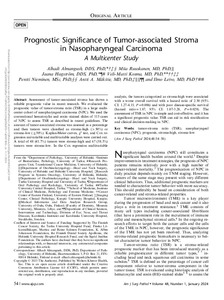Prognostic Significance of Tumor-associated Stroma in Nasopharyngeal Carcinoma: A Multicenter Study
Almangush, Alhadi; Ruuskanen, Miia; Hagström, Jaana; Kosma, Veli-Matti; Nieminen, Pentti; Mäkitie, Antti A; Leivo, Ilmo
Prognostic Significance of Tumor-associated Stroma in Nasopharyngeal Carcinoma: A Multicenter Study
Almangush, Alhadi
Ruuskanen, Miia
Hagström, Jaana
Kosma, Veli-Matti
Nieminen, Pentti
Mäkitie, Antti A
Leivo, Ilmo
Julkaisun pysyvä osoite on:
https://urn.fi/URN:NBN:fi-fe2025082791452
https://urn.fi/URN:NBN:fi-fe2025082791452
Tiivistelmä
Assessment of tumor-associated stroma has shown a reliable prognostic value in recent research. We evaluated the prognostic value of tumor-stroma ratio (TSR) in a large multicenter cohort of nasopharyngeal carcinoma (NPC). We used the conventional hematoxylin and eosin-stained slides of 115 cases of NPC to assess TSR as described in recent guidelines. The amount of tumor-associated stroma was assessed as a percentage and then tumors were classified as stroma-high (>50%) or stroma-low (≤50%). Kaplan-Meier curves, χ2 test, and Cox regression univariable and multivariable analyses were carried out. A total of 48 (41.7%) tumors were stroma-high and 67 (58.3%) tumors were stroma-low. In the Cox regression multivariable analysis, the tumors categorized as stroma-high were associated with a worse overall survival with a hazard ratio of 2.30 (95% CI: 1.27-4.15, P=0.006) and with poor disease-specific survival (hazard ratio=1.87, 95% CI: 1.07-3.28, P=0.029). The assessment of TSR in NPC is simple and cost-effective, and it has a significant prognostic value. TSR can aid in risk stratification and clinical decision-making in NPC.
Kokoelmat
- Rinnakkaistallenteet [27094]
